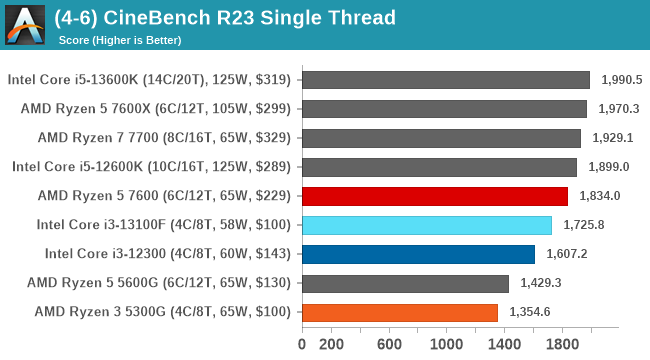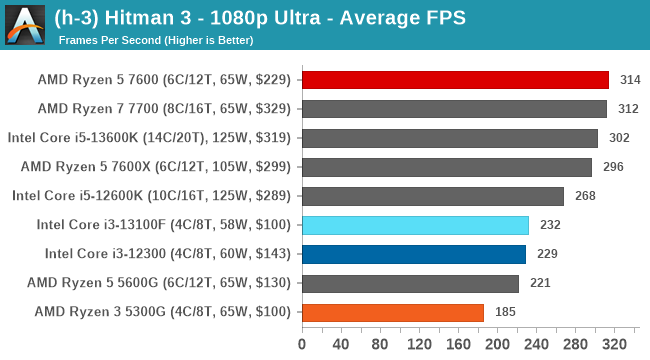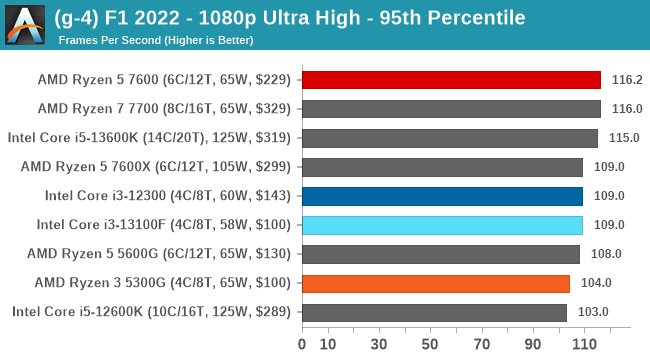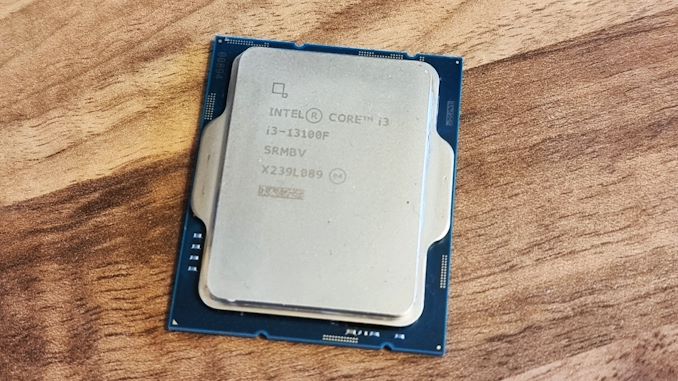The Intel Core i3-13100F Review: Finding Value in Intel's Cheapest Core Chip
by Gavin Bonshor on April 20, 2023 9:00 AM ESTConclusion
It feels like it's been ages since a quad-core CPU was considered an essential SKU in Intel's arsenal. Throughout many generations of Intel's architectures, including the fabled Sandy Bridge, Haswell, and Skylake, to name a few, it wasn't until the launch of its Coffee Lake family of parts (8th Gen Core) that we saw Intel going beyond four cores for its desktop platform. Since then, Intel hasn't looked back. They have iteratively increased their core/thread counts with the optimization and efficiency of their manufacturing processes, leading to processors with core counts that would have seemed absurd at the start of the Sandy Bridge era.
But, in 2023, is there value to be had in a desktop CPU that offers just four CPU cores? Right now, a four core CPU is certainly at the extreme end of matters for an Intel desktop platform, with the same 13th Gen Core series offering up to 24 cores on its top SKUs. The same can be said for AMD's top-tier offerings, such as the Ryzen 9 7950X, the gaming-centric Ryzen 9 7950X3D, and Ryzen 9 7900X3D, as well as the most recent Ryzen 7 7800X3D. The issue, of course, is that not everyone can afford such an expensive CPU as the ones mentioned above, which typically cost upwards of $600. That's where options such as the quad-core Intel Core i3-13100F come into play with a far friendlier price tag of $100.
Even in the sub $150 space, AMD has the previous generation Ryzen 5 5600G 6-core APU, which is currently $138 at Amazon, and the entry-level quad-core Ryzen 3 5300G. Although the Ryzen 3 5300G was OEM only at its launch, these days it's publicly available for around $100, making it AMD's most recent quad-core offering on the market. With the Core i3-13100F also running for $100 at Amazon currently, the budget space certainly has plenty of options to select from, but it's time to see how the latest quad-core from Intel stacks up against the rest.
Intel Core i3-13100F Performance Analysis
Let's make no mistake about it; the Core i3 series isn't designed for heavy and intensive workloads, multi-threaded performance, or tasks such as video rendering and encoding, but for an MSRP of $109 and a current selling price of $100 at Amazon, quad-core desktop systems aren't dead, at least not yet. As we've done recently in our CPU reviews, we're splitting our analysis into two sections, compute performance and gaming performance.
Intel Core i3-13100F: Compute Performance, Four Cores has Limitations
Looking at how Intel's latest quad-core offerings compete in the sub $350 processor market, as expected, compute performance is limited considerably in workloads that are optimized for higher core counts. Judging the Core i3-13100F on its merits without comparing performance to the more extensive and much more expensive AMD Ryzen 9 7950X 16C/32T and Intel Core i9-13900K 24C/32T flagships, the Core i3-13100F does very well all things considered.

In our Persistence of Vision Raytracer (POV-Ray) benchmark, we can see that in an optimized multi-threaded workload, the four cores of the Core i3-13100F make it faster than every other quad core chip in our charts – handily surpassing AMD's quad 5300G by around 28% at the same price – but still noticeably behind more expensive chips with more cores. MT-loving workloads are, essentially, what these cheap chips are giving up on in order to keep their costs down and fill out their respective CPU product stacks.

Using the CineBench R23 Single-Threaded test to show the single-threaded performance of the chips tested in this review, we can see that the Core i3-13100F offers an improved result of around 7% compared to the Core i3-12300 for a small 2% bump in turbo core frequency (4400 versus 4500 MHz). That's a respectable gain in single-threaded performance, and multi-threaded performance has been improved by around 4-8% throughout most of our compute testing compared to the Core i3-12300. Comparing it to the Ryzen 3 5300G, the Core i3-13100F is ahead by around 21% in CB23 ST. Meanwhile, in a sign that things aren't quite as stratified overall for the CPU market when it comes to single/lightly-threaded workloads, the i3-13100F is only 5% behind the $229 Ryzen 5 7600, AMD's most budget-friendly Zen 4 architecture chip.
It's a similar story across the majority of our compute-focused test suite, with the Core i3-13100F typically edging the previous generation Core i3-12300 out marginally and coming in with lower levels of performance against AMD's cheapest Ryzen 7000 series processor, the Ryzen 7 7600 which does have six Zen 4 cores under its hood. In multi-threaded tasks, the $138 Ryzen 5 5600G (6C/12T) APU performs remarkably well for its price tag, despite being from the previous generation Zen 3 line-up. As an added bonus, this chip is an APU, it has superior integrated graphics, which for titles outside of recent AAA, is still solid for 60 FPS gaming at low resolutions with lower levels of settings.
Intel Core i3-13100F Gaming Performance: Decent Performance, but Again, has Limitations
Moving onto gaming performance, we can see that gaming with the Core i3-13100F at 720p and 1080p has certain limitations by having just four cores. Despite having superior IPC performance compared to Intel's previous generations, many games now are multi-platform console ports, which is to say that they've been designed around a larger number of CPU cores (and may be questionably optimized for the PC at all).

Despite having a measly four Golden Cove performance (P) cores under the hood, the Core i3-13100F still performs considerably well when paired with an AMD Radeon RX 6950 XT graphics card. Results may vary when paired with lower-end discrete graphics, though as these are all CPU-limited scenarios, most of these trends will hold Still, comparing things on a level basis, e.g., with memory at the highest-rated JEDEC specifications (DDR5-4800 over DDR4-3200) and the same hardware, the Core i3-13100F shows itself as more than good enough to spit out an acceptable number of frames in the games we've included in our benchmark suite.

We saw highly competitive performance between the Core i3-13100F and Core i3-12300, which is to be expected given they are essentially the same processor; one is just badged as 13th Gen and has 100 MHz more on the turbo core clock speeds.
Ultimately, we're not expecting that users going for a gaming system based around a i3-13100 or i3-13100F are aiming for a high-end experience. But quad core chips can't be written off wholesale for budget gaming systems – at least not yet. As multi-platform games shift from the previous gen consoles being the baseline to the current generation, Zen-2 based fare, that will understandably change. But right now there's still a lot a quad core CPU can handle, especially if you're being equally thrifty on the software side of matters and working through your Steam backlog (ed: guilty).
Intel is offering its chips on a cheaper core-to-price ratio, and delivering respectable performance levels at entry-level and mid-range price points. Diving a little deeper into the pricing, the Core i3-13100F costs roughly $25 per core, which drops to $22 per core on the Core i5-13600K. Which makes the latter technically a bit cheaper per core, but it should also be noted that only six of these are P cores, while the remaining eight are lower-performing E cores.
Meanwhile, the Ryzen 5 5600G ($138) costs $23 per core, and the Ryzen 3 5300G ($100) costs $25 per core. Although this isn't a metric that should be entirely relied upon just for performance purposes, it's certainly interesting.
Final Thoughts: Core i3-13100F is Solid at $100 – Just Bring Your Own Video Card
In 2023, technology will continue to evolve, and the demand for processing power will increase. Many entry-level laptops and desktops still have quad-core processors and are perfectly adequate for everyday use. This doesn't always hold for more CPU-intensive tasks, of course, but that's the nature of making a trade-off with a cheaper CPU.
As things stand, while more advanced software such as video editing or 3D rendering may require more processing power, four cores can still perform reasonably for many users. This is especially true if the software is not heavily multi-threaded, meaning it cannot take full advantage of multiple cores simultaneously. In such cases, a quad-core processor such as the Core i3-13100F may provide comparable performance to a higher-core-count processor that is not fully utilized. This is more prevalent in single-threaded applications, but Intel has opted for its Golden Cove performance cores instead of its newer Raptor Cove cores as its go-to cores. This makes the 13th Gen Core i3 series more of a refresh with a clock speed bump than a new product.
Still, it is worth noting that technological advancements have allowed processors to become more efficient and effective in utilizing their available cores. This means that even with just four cores, modern processors can still handle more demanding tasks than before through gains to IPC performance and increases in core clock speeds while remaining at a similar power curve to the previous generation.
If Intel had used its newer Raptor Cove performance (P) cores as it does with its other 13th Gen Core i7 and i9 series, Intel could probably have squeezed out some more performance. Still, it's understandable as it would have inflated the Core i3 pricing up, and with only four cores, it would still be limited in multi-threaded scenarios.
Which brings us to Intel's Core i3-13100F. Intel's cheapest quad core processor in the 13th Gen Core processor stack is an improvement over the 12th Gen Core i3 offerings, though it's rather marginal. The biggest improvement, really, isn't on performance, but rather on price (and thus cost effectiveness). Especially with current retail pricing of just $100, the i3-13100F is a much better deal than the 12th Gen i3 chips it replaces. It's clear that Intel has been meticulous about fine-tuning their product stack, and while the i3-13100F doesn't bring anything new to the table in terms of technology or performance, it does a good job of filling the need for a cheap quad core chip within Intel's lineup.
Not that Intel is being solely insular, here. In the budget market AMD's previous Ryzen 5 5600G ($138) and Ryzen 3 5300G ($100) chips put up a fight, which does shake things up from a performance and pricing perspective. From a pure CPU performance perspective Intel has the better quad core chip, but AMD does have an edge in offering integrated graphics at the same price. It's not an unfamiliar trade-off in this space; system builders who need integrated graphics as well can either turn to AMD's chip or step up to Intel's full i3-13100 ($110), otherwise if you're going the BYOG route, the i3-13100F is in a better position to let everything ride on CPU performance.
For what it's worth, Intel does end up with a slight edge on some platform aspect as well – support for both DDR5 and DDR4 memory come to mind – though even with the recent drops in DDR5 memory prices, it's hard to make an argument for the more expensive memory with such a cheap chip. Still, the use of the common LGA 1700 platform means that i3-13100F systems also leave the door open to upgrading to a more powerful current-generation Raptor Lake processor later on, as rare as that will be.
In summary, while the demand for processing power increases in 2023, the Core i3-13100F can still be a viable and practical option for many users, especially at the entry-level, where basic photo manipulation, word processing, and web browsing are all going on – so long as you bring your own video card.
As stated throughout the review, the Intel Core i3-13100F is currently available for $100 at Amazon. In our opinion, it represents good value for money for entry-level users or when building a system where heavy workloads aren't a key factor. When combined with a motherboard such as the ASRock B660M-HDV ($95) and a 16 GB kit of TeamGroup T-Force Vulcan Z DDR4-3200 memory ($40) for a total of $255, users can use the rest of whatever budget is left on a graphics card which will predominantly set what the system is capable of in gaming.











34 Comments
View All Comments
porina - Thursday, April 20, 2023 - link
"Kaby Lake family of parts (8th Gen Core)" 8th gen was Coffee Lake.Interesting overall. I'd consider 6 core as entry level for anything other than the most basic tasks and 8 isn't that much a stretch.
Ryan Smith - Thursday, April 20, 2023 - link
Ahh, you're right. We got Kaby, and then Coffee, and then Coffee again. Thanks!adamxpeter - Thursday, April 20, 2023 - link
"but for an MSRP of $109 and a current selling price of $100 at Amazon" - then why $119 on the diagrams?Gavin Bonshor - Friday, April 21, 2023 - link
Thank you for pointing this out. I've changed it. When I made the graphs, that was the price, and I just forgot to update it.nrencoret - Thursday, April 20, 2023 - link
Although I like the article, I think the value comes in the form of the 5600g. I think the author should have focused attention not on the R7 but on the 5600. 20/30 USD for a more complete package seems to me like a better price/performance competitor.dwillmore - Friday, April 21, 2023 - link
That was my takeaway as well. It seemed odd to pick the F version of the 13th gen chip when everything else in the price segment had graphics. It seems an unfair bias against all of the other chips.If I was looking at a machine in this range, I'd certainly look at the 5600G. Fortunately, I am not, I just retired a 3700X to my kids PC.
lightningz71 - Thursday, April 20, 2023 - link
Why, oh why, are we pitting a 13100F against the 5300g? If you are dredging the bottom of the barrel, you need to look at the Ryzen 5500, which is going for $96 at amazon right now. It has NO video, matching the 13100f, has TWO more cores, and a higher boost than the 5300g. The two additional cores significantly extend it's useful life and opens higher end, more modern games to the user. It can go on any of the AM4 boards easily as well. In addition, having TWICE the L3 cache of the 5300g makes a notable impact on many titles. Yes, I doubt it wins in single threaded benchmarks, but in practicle use, its likely an overall netter choice!Ryan Smith - Friday, April 21, 2023 - link
Picking the competition for low-end chips is always a bit of a challenge due to the sheer number of options. There's the last-gen stuff, the current-gen stuff, the higher-tier last-gen stuff that's had price cuts, random SKUs that may or may not have received permanent price cuts, etc. And of course, what chips we have on hand, since AMD and Intel don't sample their complete product stacks.We opted to focus on the true low-end parts, in part because that's what we have available, and because I'm not convinced a $99 chiplet Ryzen is going to hang around. But you're definitely correct that there are additional comparisons we could have made.
DirtyLoad - Wednesday, April 26, 2023 - link
Hi Ryan,I like the article, but the better chip to compare is the 5600. It has double the L3 of the 5600g, which is just a 5500 with graphics. Wouldn't the extra cache help on some games/programs.
Samus - Sunday, April 23, 2023 - link
I would argue the 'practical' use these budget chips target greatly benefit from stronger, not more cores, and Intel wins that department when comparing Zen3 Ryzen 5xxx parts to 12\13 gen.